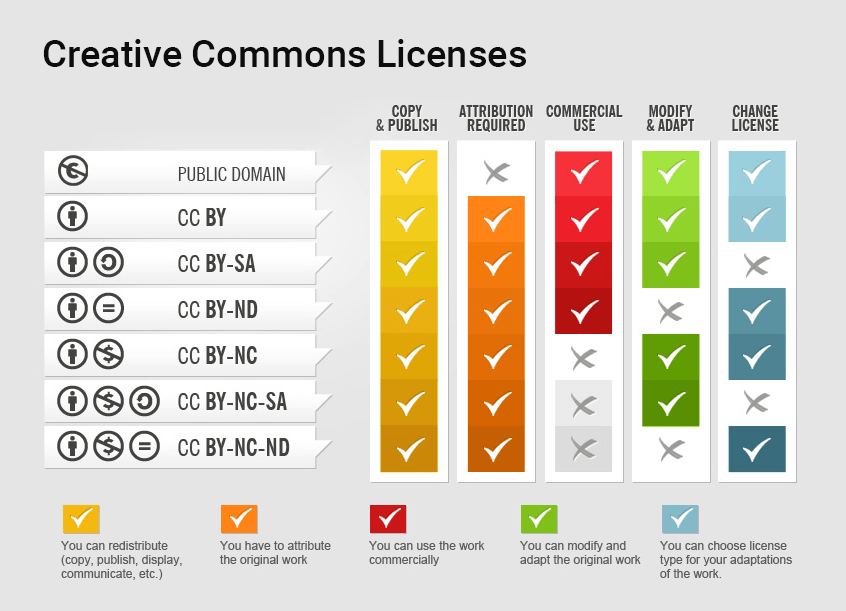Stock Photo Licenses Explained
Rights Managed (RM) and Editorial Use Licenses will likely not be needed for images used on School of Medicine websites so will not be addressed here.
Royalty Free License (RF)
The name “royalty free” can be misleading as these images are not free. Generally you pay a one-time fee or monthly membership fee for the right to download and use these images. The fee-based stock photography sites listed below fall under this category.
Creative Commons
A Creative Commons (CC) license permits certain uses of copyrighted materials by the public at large. If a work you wish to use has been released under a CC license, you do not have to request permission to use the image in order to use it as authorized by the license. Note that, you still need to follow the license terms. For example, the license may require attribution to the original author or it may forbid commercial use.
You must obtain permission from the creator to do anything that goes beyond the terms of the license (eg: making commercial use of the work or creating a derivative work when the license does not permit this).
Besides the Creative Commons Zero (CC0) license, CC materials retain a copyright. The creator of the work does not lose the copyright for the work, rather they choose to share the work with the public under certain conditions. If you breach the license by using the material in a way that is not permitted, standard copyright laws apply.
There different CC licenses have letter pairs that indicate conditions for use:
- CC BY
- CC BY-SA
- CC BY-NC
- CC BY-ND
- CC BY-NC-SA
- CC BY-NC-ND
Each of these licenses allow the public to use the material in different ways.

Attribution (BY)
You must credit the creator, the title and the license the work is under. This is required for all these Creative Commons licenses. For information on how to attribute a work, see ‘How to Give Attribution.’

Share Alike (SA)
Any new work produced using this material must be made available under the same license as the original work. For example, if you remix a work under an Attribution-Share Alike license, you have to release the new work you create under an Attribution-Share Alike license.

Non-commercial (NC)
Any use of the work must be for non-commercial purposes only. For example, file sharing, educational use and film festivals are all allowed, but advertising and for-profit uses are not.

No Derivative Works (ND)
The work can only be used exactly how it is. The work cannot be adapted or modified in any way. This means you will need to get extra permission if you want to remix the work, crop a photo, edit down text or use a song in a film.
The figure below shows a good overview of what each license permits you to do.

“How To Attribute Creative Commons Photos” by Foter is licensed under CC BY-SA 3.0.
Check out the Creative Commons website for more information and details about the different CC licenses.
Creative Commons Zero (CC0)
Creative Commons offers a Public Domain Dedication, known as CC0. I wanted to highlight this particular license since many of the free stock image resources listed below use this license.
As stated on the Creative Commons website: Dedicating works to the public domain is difficult if not impossible for those wanting to contribute their works for public use before applicable copyright or database protection terms expire. Few if any jurisdictions have a process for doing so easily and reliably. CC0 helps solve this problem by giving creators a way to waive all their copyright and related rights in their works to the fullest extent allowed by law.
Images licensed under the CC0 are free from copyright restrictions. This means you can copy, modify and distribute the work, even for commercial purposes, all without asking permission.
Although CC0 doesn’t legally require users to cite the source, it is often appreciated (and the right thing to do).
Public Domain
When a photo is in the public domain, it means the rights of its creators have expired and that the image has become available for the broader public to use – without charge and without having to credit the creator. But be careful: There is no universal standard for when an image becomes part of the public domain, as this depends on the country where it was first created.
Related Videos
Creativity, Copyright, and Fair Use
4 min. 40 sec.
What Does “Creative Commons” Mean?
5 min. 47 sec.